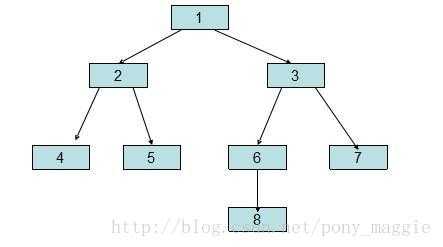标签:src 相关 create new 二叉搜索树 取出 div 实现 分享
该文我会用来总结二叉树相关的知识
二叉树如下图:

二叉树的结构
struct TreeNode {
int val;
TreeNode *left;
TreeNode *right;
TreeNode(int x) : val(x), left(NULL), right(NULL) {}
};
二叉树构造方法
为了测试二叉树的的各种算法,我不得不写一个二叉树的构造方法,我主要是用层次遍历的方式来构造二叉树的。层次遍历在后面会详细说到。
用字符串的方式来输入二叉树的序列,例如:
输入:1 2 3 4 5 6 7 null null null null null 8 null null
以上输入都是字符,最后两个null可省略。
1 TreeNode *createBinaryTree(vector<string> &arr){
2 TreeNode *head = NULL;
3 if (!arr.at(0).compare("null"))return head;//空树
4 queue<TreeNode *>Q;
5 vector<string>::iterator it = arr.begin();
6 head = new TreeNode(stringToInteger(*it++));//stringToInteger将string转为int
7 TreeNode *p = NULL;
8 Q.push(head);//树根入队
9 //队列不空,且没超过arr的大小(用于arr最后多余的null未列出来的情况,即上面说的可省略的情况)
10 while (!Q.empty() && it != arr.end()){
11 p = Q.front();//取出队首元素
12 Q.pop();
13 if (!(*it).compare("null")){//arr序列的下一个为空,则左子树为空
14 p->left = NULL;
15 }
16 else{//否则生成左子树
17 p->left = new TreeNode(stringToInteger(*it));
18 Q.push(p->left);//左子树入队
19 }
20 ++it;
21 if (it == arr.end())break;//不忘判断arr是否越界
22 if (!(*it).compare("null")){//arr序列的下一个为空,则右子树为空
23 p->right = NULL;
24 }
25 else{//否则生成右子树
26 p->right = new TreeNode(stringToInteger(*it));
27 Q.push(p->right);//右子树入队
28 }
29 ++it;
30 }
31 return head;
32 }
用数值的方式来输入二叉树的序列,例如:
输入:1 2 3 4 5 6 7 -1 -1 -1 -1 -1 8
默认树的所有值都是大于0的。
TreeNode *createBinaryTree(const vector<int> &arr){
int index = 0;
queue<TreeNode *>Q;
TreeNode *head = new TreeNode(arr.at(index++));
Q.push(head);
TreeNode *p = NULL;
while (index < arr.size() && !Q.empty()){
p = Q.front();
Q.pop();
if (arr.at(index) >= 0){
TreeNode *temp = new TreeNode(arr.at(index));
p->left = temp;
Q.push(temp);
}
++index;
if (index >= arr.size())break;
if (arr.at(index) >= 0){
TreeNode *temp = new TreeNode(arr.at(index));
p->right = temp;
Q.push(temp);
}
++index;
}
return head;
}
二叉树遍历方法
前序遍历:1->2->4->5->3->6->8->7
中序遍历:4->2->5->1->8->6->3->7
后序遍历:4->5->2->8->6->7->3->1
层次遍历:1->2->3->4->5->6->7->8
前序递归实现:
1 vector<int> preorder(TreeNode* root){
2 vector<int> retInt;
3 if (root == NULL)return retInt;//空树
4 retInt.push_back(root->val);//先访问值
5 vector<int> left = preorder(root->left);//进入左子树
6 retInt.insert(retInt.end(), left.begin(), left.end());//复制左子树的访问结果
7 vector<int> right = preorder(root->right);//进入右子树
8 retInt.insert(retInt.end(), right.begin(), right.end());
9 return retInt;
10 }
前序费递归实现:
1 vector<int> preorder(TreeNode* root){
2 vector<int>retInt;
3 if (root == NULL)return retInt;//空树
4 stack<TreeNode *>s;
5 s.push(root);//树根入栈
6 while (!s.empty()){
7 TreeNode *p = s.top();
8 retInt.push_back(p->val);//先访问值
9 if (p->left != NULL){
10 s.push(p->left);//遍历左子树,左子树入栈
11 }
12 else{//左子树为空
13 s.pop();//当前节点出栈
14 while (p->right == NULL && !s.empty()){//寻找非空右子树
15 p = s.top();
16 s.pop();
17 }
18 if (p->right != NULL)s.push(p->right);//右节点入栈
19 }
20 }
21 return retInt;
22 }
中序递归实现:
1 vector<int> inorder(TreeNode* root){
2 vector<int> retInt;
3 if (root == NULL)return retInt;//空树
4 retInt = inorder(root->left);//遍历左子树
5 retInt.push_back(root->val);//访问当前节点值
6 vector<int> temp = inorder(root->right);//遍历右子树
7 retInt.insert(retInt.end(),temp.begin(),temp.end());//复制右子树的结果
8 return retInt;
9 }
中序非递归实现:
1 vector<int> inorder(TreeNode* root){
2 vector<int> retInt;
3 if (root == NULL) return retInt;//空树
4 TreeNode *p = NULL;
5 stack<TreeNode *> s;
6 s.push(root);//树根入栈
7 while (!s.empty()){
8 p = s.top();//获取栈顶元素
9 if (p->left != NULL){
10 s.push(p->left);//其左子树入栈
11 }
12 else{//左子树为空时
13 s.pop();
14 retInt.push_back(p->val);//访问其节点值
15 while (p->right == NULL && !s.empty()){//寻找非空右子树
16 p = s.top();//若右子树为空,获取新的栈顶元素
17 retInt.push_back(p->val);//访问新元素的值
18 s.pop();
19 }
20 if (p->right != NULL)s.push(p->right);//右子树入栈
21 }
22 }
23 return retInt;
24 }
后序的递归实现:
1 vector<int> postorderTraversal2(TreeNode* root){
2 vector<int> retInt;
3 if (root == NULL)return retInt;//空树
4 retInt = preorderTraversal2(root->left);//进入左子树
5 vector<int> right = preorderTraversal2(root->right);//进入右子树
6 retInt.insert(retInt.end(), right.begin(), right.end());
7 retInt.push_back(root->val);//最后访问值
8 return retInt;
9 }
后序的非递归实现:
总结:
前序、中序、后序
用法:
LeetCode的Binary Tree Inorder Traversal可用中序遍历来检查,二叉搜索树的中序遍历结果是递增的。
标签:src 相关 create new 二叉搜索树 取出 div 实现 分享
原文地址:http://www.cnblogs.com/yeqluofwupheng/p/6661399.html